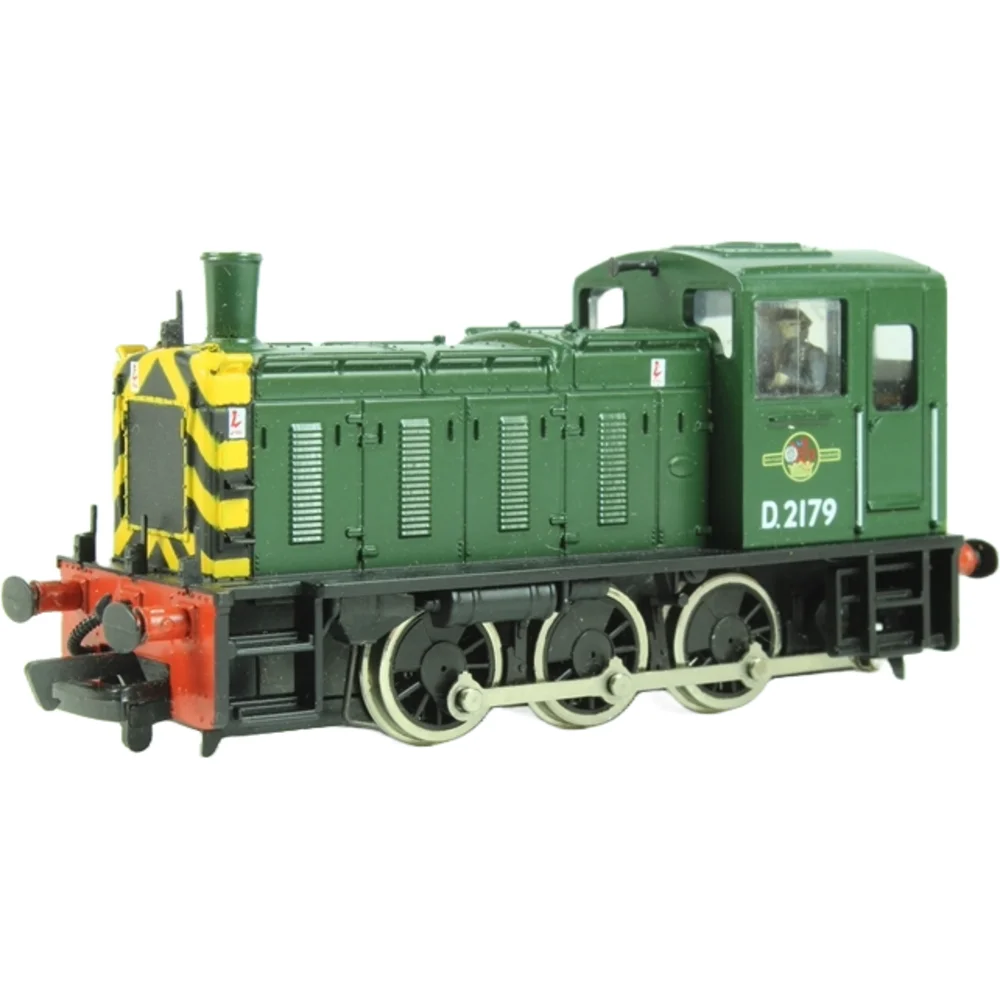Mainline 37037
British Rail Class 03 D2179 British Railways Green with Late Crest
Tooling
In 1991, Bachmann relaunched the British Rail Class 03 shunter in OO gauge using tooling inherited from Mainline (originally introduced in 1982). This marks the first iteration of Bachmann's Branchline Class 03, preceding later retoolings in 2010 and 2017. The model provided an affordable and accurate representation of BR’s small 0-6-0 diesel-mechanical locomotive as originally produced by Mainline, before Bachmann’s technical enhancements.
Tooling Features
- Scale: OO gauge (1:76), first-radius capable (minimum 371 mm diameter) – aligns with early Mainline design parameters.
- Construction: Plastic body shell with separate detailing (handrails, chimney, horn, lamps, windscreen wipers); die-cast chassis, split-style underframe from Mainline inheritance.
- Detailing: Cab interior with driver figure, glazing, buffer beams, pipework, sandboxes, and underframe components faithfully model the real Class 03.
- Couplings: Supplied with non-NEM tension-lock couplings permanently mounted to the chassis; conversion requires modification.
Mechanical & Electrical
- Motor & Drive: Retrofitted to a more reliable can motor within Bachmann tooling; jackshaft drive mechanism traces back to the Mainline system.
- Pickup & Wheels: Two-wheel pickup, all wheels driven for solid traction; chassis weighting ensures good adhesion.
- Minimum Radius: Handles first radius curves (371 mm) comfortably.
- Lighting: No built-in lighting on early tooling.
- Weighting: Die-cast chassis provides necessary ballast for smooth operation and pulling power.
DCC Capability
- Initial ex-Mainline variants (circa 1991) were DCC-incompatible, lacking sockets and decoder readiness.
- Later revisions prior to 2010 remained analogue-only; any DCC fitting required hardwiring.
Liveries Produced
Early Bachmann tooling saw production in:
- BR green with late crest;
- BR blue with “wasp stripes”;
- Depot-specific variations with accurate numbering.
Reviews & Commentary
- Praised for smooth running compared to Mainline predecessors, though still basic by modern standards.
- Detailing considered good for its era, especially cab glazing and handrails.
- Criticism focused on split-chassis reliability and lack of easy coupling upgrades.
Media & Social Media Insights
- Forum discussions note its suitability for small layouts thanks to first-radius capability.
- Collectors highlight its historical significance as Bachmann’s first UK diesel shunter tooling.
Other Interesting Information
- Recommended run-in period to settle gears and improve performance.
- Conversion to finer couplings often involved aftermarket kits or scratch modifications.
Class & Prototype
- Class: British Rail Class 03
- Traction: Diesel
- Transmission: Mechanical
- Built: 1957-1961
- Total Built: 230
The BR Class 03 was British Railways' standard light diesel-mechanical shunter, with 230 built at Doncaster and Swindon Works between 1957-1962. Powered by the legendary Gardner 8L3 engine and featuring distinctive jackshaft drive with coupling rods, these 30-ton locomotives excelled on weight-restricted lines, docks, and industrial sidings where heavier Class 08s couldn't operate. Notable variants included nine cut-down cab examples for the Burry Port & Gwendraeth Valley Railway and two for Isle of Wight tunnel clearance. With 56 preserved (24% survival rate) and the last example working until 2008, the Class 03 remains popular with heritage railways and modellers alike.
No prototype found.
Operator & Livery
- Operator: British Railways
- Livery: Green with Late Crest
British Railways transformed Britain's fragmented rail network into a unified national system following nationalisation on 1st January 1948. Created from the "Big Four" companies under the Transport Act 1947, BR operated most of Great Britain's railways until rebranding as British Rail in 1965, managing over 20,000 route miles and inheriting nearly 20,000 locomotives of diverse designs.
The organisation pioneered standardisation through its revolutionary BR Standard locomotive programme (1951-1960), producing 999 advanced steam engines under Robert Riddles' direction. These included the versatile Britannia Pacifics, mighty 9F freight engines, and mixed-traffic classes that incorporated the best features from all predecessor companies. The 1955 Modernisation Plan accelerated diesel and electric traction development, creating fascinating mixed-traction operations.
Notable achievements included establishing unified locomotive classification systems, introducing distinctive corporate liveries, and managing the complex transition from steam to modern traction. BR's six regional structure preserved operational diversity whilst enabling standardisation of practices, signalling, and rolling stock that had eluded private enterprise for over a century.
The BR era represents steam traction's final flowering alongside emerging diesel technology, creating unparalleled locomotive variety. Today, this heritage remains highly popular with railway enthusiasts through extensive preserved fleets, heritage railway operations, and comprehensive model ranges from manufacturers like Hornby, Bachmann, and Dapol, making BR subjects essential for authentic post-war British railway modelling across all scales.
